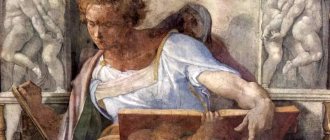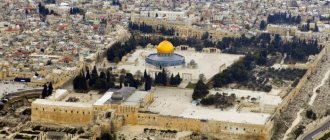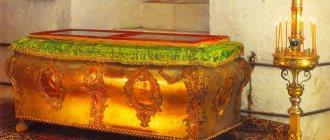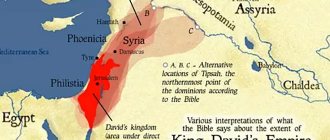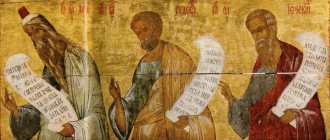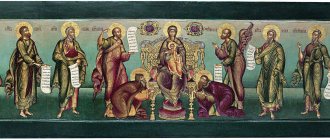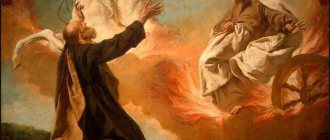Daniel, dream interpreter and lion tamer
Author Daria Sivashenkova
12/30/2011 10:00 (Updated: 07/20/2021 16:34)
Religion » Religions of Russia » Orthodoxy
The Old Testament prophet Daniel lived in the 5th century BC. Even in his youth, he was captured, but thanks to his outstanding abilities and God’s help, he managed to occupy a high government post in a foreign land and outlive six kings. We know him primarily as the author of the biblical Book of the Prophet Daniel, which contains a number of predictions not only about the near future of Babylon and Israel, but also about the coming of the Messiah to the world, as well as the end of the world. According to the text of the Gospel, Jesus Christ twice referred to the prophecies of Daniel in his conversations with the Jews.
The prophet Daniel came from a noble family. During the conquest of Jerusalem by Nebuchadnezzar in 606 BC, 15-year-old Daniel, along with other Jews, was taken into Babylonian captivity. There, among the most capable young men, he was sent to school to prepare for service at the royal court. The king acted cunningly. On the one hand, he prevented uprisings - after all, if there are no talented youth left in the country, in the future there will simply be no one to lead it and all that remains is to come to terms with the power of the invaders. On the other hand, these young men were given an excellent education and made them royal advisers in Babylon - with their help the king made reasonable decisions.
After finishing his studies, Daniel and three friends were assigned to serve at the royal court and remained here in the rank of court dignitary throughout the reign of Nebuchadnezzar and his five successors. After the conquest of Babylon, he became an adviser to the kings Darius of Media and Cyrus of Persia.
God gave Daniel the ability to understand the meaning of visions and dreams, and he demonstrated this ability by explaining to Nebuchadnezzar his dream, which greatly confused the king. Nebuchadnezzar dreamed of a huge and terrible image, whose “head was of pure gold, his breast and his arms were of silver, his belly and his thighs were of copper, his legs were of iron, his legs were partly iron and partly clay” (Dan. 2:31- 43). It is to this dream that we owe the expression “colossus with feet of clay.”
A stone that rolled down the mountain hit the idol on its clay feet and smashed the image into dust, after which it itself turned into a large mountain. Daniel explained to the king that the idol symbolized the four pagan kingdoms that were supposed to replace each other, starting with his own, the “golden one,” and ending with the one that would be divided and become very fragile because of this. It was the division of the kingdom that meant the mixture of iron and clay. The mysterious stone that crushed the colossus symbolized the Messiah, and the resulting mountain symbolized His eternal Kingdom.
The second dream that Daniel explained to the anxious king concerned the fate of Nebuchadnezzar himself. The ruler saw a huge, spreading tree with many fruits, from which “all flesh was nourished.” Animals hid from the heat in the shade of the tree, and birds nested in its branches. But the “Watching and Holy One” came down from heaven and ordered to cut down the tree, tear off all the leaves from it and disperse the animals and birds. To himself, the king heard menacing and incomprehensible words: “The heart of man will be taken away from him and the heart of an animal will be given to him, and seven times will pass over him.”
According to Daniel’s interpretation, the tree in the dream symbolized the king himself, whose power and might extended over the entire earth, like branches covered with leaves. But his arrogance and pride were displeasing to the Almighty, so He decided to humble Nebuchadnezzar. According to various interpretations, the king either temporarily went crazy and lived with animals, or actually took on a bestial appearance.
“He was separated from people, ate grass like an ox, and his body was watered with the dew of heaven, so that his hair grew like a lion, and his nails like a bird,” says the Book of the Prophet Daniel. But this passed, and reason returned to the king, and he wisely did not grumble against God. On the contrary, the ruler who came to his senses expressed warm gratitude to the Almighty for the lesson of humility.
The second king to recognize Daniel's prophetic gift was the husband of Nebuchadnezzar's daughter, Belshazzar, who inherited the throne of her father. One day he was feasting with his entourage, wives and concubines, and at the feast he praised the idols known to him. “They drank wine and praised the gods of gold and silver, copper, iron, wood and stone,” says the Book of Daniel. This did not go unpunished: suddenly the king saw a human brush appear in the air, inscribing three incomprehensible words “Mene tekel upharsin” on the stone wall. The frightened king asked his wife where the great sage was, about whom her father had spoken so much, and Daniel appeared before Belshazzar.
First of all, he set the ruler as an example and reproach of his predecessor Nebuchadnezzar, who received a lesson in humility from God and truly humbled himself. Belshazzar continued to glorify his idols, for which he will be punished. “This is the meaning of the words: me - God has numbered your kingdom and put an end to it; Tekel - you are weighed on the scales and found very light; Peres - your kingdom is divided and given to the Medes and Persians,” Daniel ominously predicted. Trying to cajole heaven, Belshazzar proclaimed the prophet “the third ruler in the kingdom,” but this did not help. The idolatrous king was killed that same night, and his throne was taken by the Median king Darius.
Under Darius, Daniel occupied an important government post and almost became the deputy of the king himself. But the pagan nobles, envious of such a career, slandered him before Darius. The fact is that this king also suffered from the sin of pride and demanded that for 30 days no one in the kingdom dare ask the gods or man for anything. Requests could only be made to the king himself. But Daniel disregarded this decree, praying daily to the Most High God. The nobles reported this to the king and got Daniel thrown to the lions.
The king, angry at the disobedience, did so. Daniel was thrown into a ditch, and Darius mockingly suggested that the prophet pray that God would save him. But, apparently, the king was not alien to conscience: he even lost his appetite from his act. “Then the king went to his palace, went to bed without supper and did not even order food to be brought to him, and sleep fled from him,” says the Book of Daniel. And already at dawn, the completely repentant and upset king ran to the place of execution: “And, approaching the ditch, he called to Daniel in a plaintive voice, and the king said to Daniel: Daniel, servant of the living God! Could your God, whom you always serve, save you from the lions?
Of course, the answer to the king should have been only a lion's roar. But God kept his prophet unharmed: the predators only fawned on him all night. Having examined the matter, Darius ordered the slanderers of Daniel to be subjected to the same execution, and the lions did not spare them.
In addition to interpreting the king's dreams, in his book the prophet Daniel recorded several prophetic visions relating to the end of the world and the second coming of Christ. In its content, his book has much in common with the Apocalypse of John the Theologian. For example, Daniel received several revelations concerning the coming of the Son of God to earth. In particular, it was the revelation of the 70 weeks, which indicated the time of the first coming of the Messiah, about the various kingdoms in the guise of wild and strange beasts. It was also revealed to him in a vision that the Messiah would be the Son of Man. Daniel learned many other wondrous revelations from dreams sent to him by God.
During the reign of Cyrus, Daniel remained in the same court rank. This king was also an idolater and one day asked his close adviser: why doesn’t he bow to idols? Daniel calmly replied that these were just lifeless idols. They argued with the king, who claimed that the god Vir eats huge amounts of food every day. The prophet managed to prove to the king that the donated food was actually consumed not by the idol, but by the priests and their families. For the priests, this ended in tears: the king ordered them to be killed, and the temple of the idol was given to Daniel, who immediately destroyed it.
But then the Babylonian nobles began to be indignant at the king, fearing that Cyrus would become a Jew by faith. They demanded that the king get rid of Daniel. The ruler agreed, and Daniel... was again thrown into the lions' den. Either this was the most popular execution, or the king did not know that he was repeating himself, or he hoped that Daniel would be saved again... But it is unlikely, for, unlike Darius, Cyrus did not come the next day to save his adviser, but looked in I’m tearing up only after a week to grieve for him. But Daniel was alive again - the old familiar lions did not touch him. The astonished king pulled him out of the ditch, and threw Daniel’s opponents into it, and then the predators had lunch.
Daniil actively participated in the political life of the state. Not without his participation, in 536, King Cyrus issued a decree on the release of Jews from captivity. According to legend, the prophet Daniel showed Cyrus a prediction about him in the book of the prophet Isaiah, who lived two hundred years before. Struck by this prophecy, the king recognized the power of God over himself and ordered the Jews to build a temple in His honor in Jerusalem.
Nothing is known about the subsequent fate of the prophet Daniel. We only know that he died at a ripe old age.
Curator: Olga Gumanova
Topics bible prophecy old testament prophet daniel
Under Roman rule
During the Roman kingdom, during the reign of the emperors, in particular Tiberius, Jesus Christ appeared in the land of Judea, in Bethlehem, that is, it was the very stone that destroyed all pagan religions.
It is no coincidence that He was also called the Savior of the world. He brought a new religion to earth, called Christian after His name...
Daniel, in his book of prophecies, foretold the long reign of the Romans.
He was the first to foresee that they would come to Israeli land, capture and destroy Jerusalem, they would devastate, plunder and destroy the Jerusalem Temple, located on the Temple Mount, which from the 10th century BC to the 1st century AD was the center of the religious life of the Jewish people.
These predictions, as Daniel wrote, were received by him from God.
He was only His servant, wrote them down and left them for posterity for edification, so that future generations could bow before the honor that he, Daniel, was awarded by the Most High.
Thus, Daniel gave a warning to the people. But the ancient Greek Epicureans, followers of Epicurus, who lived more than three centuries later than Daniel and formed their own philosophical worldview, did not listen to him.
They were not afraid of the gods, they were not afraid of death, and they considered pleasure to be the highest good.
They rejected the predestination of life and assured everyone that the gods cannot care about worldly affairs, and the Universe is not ruled by one being supreme and above all vicissitudes.
Daniel foresaw their coming.
According to him, those who live without a pointer will perish. He will break against an obstacle, like ships that, deprived of helmsmen, perish from the force of the winds or, like chariots without drivers, go astray.
Worship of the shepherds. Artist J. Tintoretto
What do the four winds symbolize in Daniel's vision?
So, the sea and waters in prophecy symbolize people, nations. The Great Sea is not small peoples, but great peoples who influenced world history and left their noticeable mark on it. The four winds of heaven that fight on the great sea, what is it? The answer is in the Bible, in some of its layers:
And I will bring upon Elam four winds from the four corners of the sky and scatter them among all these winds, and there will be no nation to which the exiled Elamites will not come. And I will strike the Elamites with fear before their enemies and before those who seek their lives; And I will bring disaster upon them, My wrath, says the Lord, and I will send a sword after them, until I destroy them. (Jer.49:36,37).
And after this I saw four angels standing at the four corners of the earth, holding the four winds of the earth, so that the wind would not blow on the earth, nor on the sea, nor on any tree. (Rev. 7:1).
There were gatekeepers on four sides: east, west, north and south. (1 Chronicles 9:24)
Again, the same harmony of the Holy Scriptures: the Old and New Testaments. And we learn that the wind is a symbol of war and destruction. And the four winds symbolize the four cardinal directions.
Through a hint beacon we will connect the beginning of the prophetic part of the book of Daniel with the historical part
We go into the labyrinths of the prophecies of the book of Daniel, having a map of the right path through this labyrinth. This map contains clearly defined time boundaries of prophecies. Lighthouses are connecting links between different layers, telling about the same force, presented in different layers of prophecies, but describing it from different sides. This map also contains a clear understanding that each of the subsequent layers sheds additional light on those events that are delineated by the time boundaries defined earlier.
The seventh chapter of the book of the prophet Daniel begins with the words:
In the first year of Belshazzar king of Babylon, Daniel saw a dream and prophetic visions of his head on his bed. Then he wrote down this dream, outlining the essence of the matter. (Dan.7:1).
In the prophetic part we are sent to a time that in the historical part of the book of Daniel is after the fourth chapter. Where else is Babylon ruled by Nebuchadnezzar after being raised by God for seven years? And the fifth chapter, which describes the last day of the reign of Belshazzar, the grandson of King Nebuchadnezzar, the last ruler of the Babylonian Empire.
The same principle - we are given a new layer, from which we learn that: Daniel’s vision of the four beasts was given from God in the first year of Belshazzar (which is not stated in the historical part of the book). There is also a beacon here that connects us with past narratives. This beacon is an indication of the time in which Daniel's vision of the four beasts is given - the reign of Belshazzar, thanks to this it is possible to connect the two layers together.
The following picture emerges. After the reign of Nebuchadnezzar, in the first year of Belshazzar's reign, God gave Daniel this prophetic vision. And the prophecy about the fate of the world was given earlier, under Nebuchadnezzar, in the second chapter. temporary were set .
Consequently, the prophecies of the seventh chapter will be another layer of prophecies within the time frame indicated in the second chapter , but with additional details that were not present in the second chapter. They are important so that the reader can get a complete, clear picture of what the Lord is talking about.
Correct Interpretation of the First Visions of the Seventh Chapter of the Book of Daniel
As a result, putting together those puzzles of interpretation that have already been revealed to us in the light of Holy Scripture, the following picture appears before us.
As a result of wars that will cover large territories and in which numerous nations will be involved, four empires will come to dominance, one after another. They will be different from one another. Their description will be given by God in the following verses.
Admire God and His greatest wisdom. In a few symbols He can reveal to the sincere student of His words the amazing depths of His prophecies about the fate of the world, and help us prepare for them.
First Visions of the Seventh Chapter of the Book of Daniel
In chapter seven, Daniel is presented with several visions in one dream. Each of them is one of the layers that describe and reveal from different sides the prophecy given to Daniel in the seventh chapter, the central theme of which, as you already guessed, will be the theme of God’s judgment. For the book of the prophet Daniel is dedicated to the judgment of God and its description from all sides, including the prophetic side.
In the first of the visions presented in the seventh chapter, Daniel sees great things, i.e. big sea. And on this sea four winds fight:
Having begun his speech, Daniel said: I saw in my vision at night, and behold, the four winds of heaven fought on the great sea. (Dan.7:2).
Then he sees how, as a result of this struggle, four beasts appear and emerge from the sea:
and four great beasts came up out of the sea, different from one another. (Dan.7:3).
The Babylonian Empire is symbolized by a lion with eagle wings
Let's go further in examining the prophecies of God from the seventh chapter of Daniel:
The first is like a lion, but he has the wings of an eagle; I watched until his wings were torn out, and he was lifted up from the ground, and stood on his feet like a man, and a human heart was given to him. (Dan.7:4).
There are plenty of beacons here in order to connect together information about the same thing from different layers of Scripture.
The prophecy of the second chapter of Daniel, which sets the time boundaries , begins with the Babylonian Empire. Whether in the image or in the prophecies of the seventh chapter, there will be four empires that become world-class.
And one more beacon. Gold is the royal metal; Lion is the king of the animals; The wings of an eagle are the wings of the king of birds. Sublime images are used. Likewise, in other places in Scripture we find these images applied to the Babylonian Empire:
...the king of Babylon... Behold, he ascends like a lion from the heights of the Jordan to the fortified dwellings... (Jer. 50:43,44).
For behold, I will raise up the Chaldeans, a cruel and unbridled people, who walk across the breadths of the earth to take possession of villages that do not belong to them. He is terrible and formidable; from himself comes his judgment and his power... they fly like an eagle rushing at its prey. (Hab.1:6-8).
We add more puzzles that became clear to us with the help of Scripture. And the picture of God’s prophecies is increasingly opening up before us. As a result of the wars, the Babylonian Empire, symbolized by a lion with eagle wings, will emerge onto the world stage.
Why does the lion have wings in Daniel's prophecy?
By the way, the Word of God also helps us understand why a lion needs wings and what they symbolize:
And the word of the Lord came to me: Son of man! propose a riddle and speak a parable to the house of Israel. Say: this is what the Lord God says: a large eagle with large wings, with long feathers, fluffy, motley, flew to Lebanon and took the top off a cedar tree... And the word of the Lord came to me: tell the rebellious house: don’t you know what this means? - Say: Behold, the king of Babylon came to Jerusalem, and took its king and its princes, and brought them to Babylon. (Ezek.17:1-3,11,12).
Wings symbolize movement, wars of conquest. In this case, the wars of conquest of the Babylonian Empire are on the way to world domination. And note that the wings are applied in this case to King Nebuchadnezzar, who captured Judah. It was under Nebuchadnezzar, during his conquests, that the Babylonian Empire grew rapidly.
Don't Look Outside the Bible for Understanding God's Prophecies
We are dealing with a prophetic vision through which God wants to tell us something. How to understand what Daniel saw? Run to astrologers and fortune tellers for an explanation of what they saw? But you and I can be convinced of the futility of these people to explain the truth of God. They themselves signed in the second chapter of this book their powerlessness, both in receiving revelations from God and in their interpretation:
The Chaldeans answered the king and said: there is no man on earth who could reveal this matter to the king, and therefore not a single king, great and powerful, demanded this from any occultist, fortuneteller or Chaldean. The matter that the king demands is so difficult that no one else can reveal it to the king except the gods, whose dwelling is not with the flesh. (Dan.2:10,11).
Being pagans, they refer to the fact that only the gods have the interpretation. But you and I, being Christians, know that both the prophecy and its interpretation are from God:
...The ignorant are those who carry their wooden idol and pray to a god who does not save. Announce and say, after consulting with each other: who announced this from ancient times, said this in advance? Is it not I, Lord? and there is no other God besides Me, there is no righteous and saving God besides Me. (Isa.45:20,21).
I am the Lord, this is My name, and I will not give My glory to another, nor My praise to graven images. Behold, what was predicted before has been fulfilled, and I will proclaim new things; Before it happens, I will tell you. (Isa.42:8,9).
God announces prophecy. From Him is the interpretation of the prophecy spoken by Him:
But there is a God in heaven who reveals secrets; and He revealed to King Nebuchadnezzar what would happen in the last days... (Dan.2:28).
This is the most important condition for a correct understanding of God's prophecies! Do not look for an understanding of God's prophecies outside the Bible, it is not there and cannot be!
The Bible Explains Itself
The Bible explains itself. It itself contains prophecies and their interpretations. Our task is to be attentive and read the Bible not in the sense of reading, but in the sense of exploring. ( how to read the Bible in the previous topic. Having mastered it, you will correctly understand prophecies and navigate the Bible). This is the task facing a believer: to understand the Bible with the help of the Bible. This is the point of her research. And so that we do not doubt that this is really so, God immediately gives us a beacon:
these great beasts, which are four, mean that four kings will rise from the earth. (Dan.7:17).
Not you and no one else, not outside books from the outside, but God Himself in His Word gives an explanation of the prophecy. If believers understood this, then there would be much less disagreement and disagreement in Christianity, and much more unity around the truth.
Having received this beacon and understanding the principle of interpreting the prophecies of God with the help of the Bible itself, we will try to find an interpretation of the vision of the great sea and the four winds fighting on it. There is no explanation for this in the book of Daniel. But the Bible interprets and explains itself, which means that there is an explanation for this in its other books. In other layers:
Alas! the noise of many peoples! They make noise like the noise of the sea. Roar of the tribes! they roar like mighty waters. (Isa. 17:12).
And he says to me: The waters which you saw, where the harlot sits, are people and peoples and nations and languages. (Rev. 17:15).
Look at the harmony of the Holy Scriptures. Whether in the Old Testament or in the New, God does not change His principles. Therefore, the reader will not get lost in the interpretation of biblical prophecies. In this we see one of the most important features of God’s character, His immutability, which gives us all stability:
For I am the Lord, I do not change; therefore you sons of Jacob were not destroyed. (Mal.3:6).
